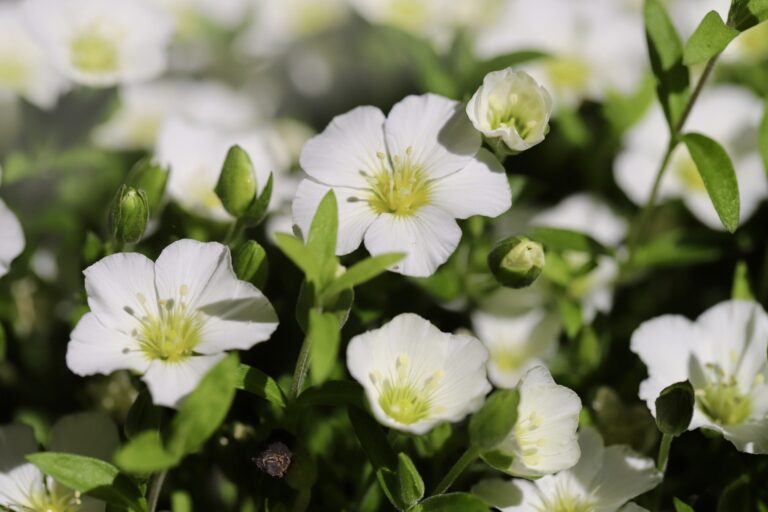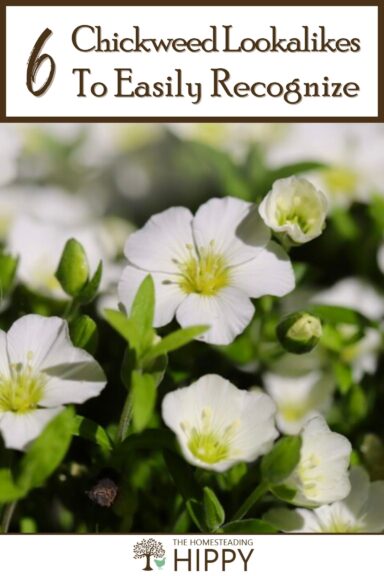Chickweed is a plant that is loved and hated in equal measure. After spreading from Eurasia to the rest of the globe, it’s adored for its pretty, petite flowers and also as a salad vegetable in some places.

But, it is persistent, fast growing and will readily take over cropland, gardens and any other disturbed ground without diligent care.
Whether you want to admire it or grow it for yourself or even as feed for chickens, you need to be careful because chickweed has several lookalikes and a few of them are quite dangerous.
Not all of them are, but this is something you can’t afford to gamble with. Keep reading and I’ll tell you all about chickweed’s lookalikes and how to distinguish them below…
Table of Contents
1. Mouse-ear Chickweed (Cerastium spp.)
The Mouse-ear Chickweed is a broadleaf weed that usually acts as a perennial, and grows up to 1 foot in height.
It’s a common weed in landscape beds and remains green all year-round with stems and leaves covered with many coarse hairs, giving it a furry appearance, Hence the common name ‘Mouse-ear’.
And although you might initially confuse Mouse-ear Chickweed (Cerastium spp.) with chickweed (Stellaria media), there are quite a few distinguishing characteristics. These two plants are not the same!
One key difference between the two is the presence of the hairs, as mentioned, while Common Chickweed has a smooth texture except the single line of larger hairs, commonly referred to as the mohawk.
Another “big” distinction is the flowers: Mouse-ear Chickweed’s flowers have five deeply notched petals, making it look like they have ten at first glance. Common Chickweed has five petals that are much less deeply notched.
And yes, Mouse-ear Chickweed is safe, a good thing since it’s often found in gardens and lawns where it form a dense mat of vegetation if you don’t curb it.
2. Four-leaved Allseed (Polycarpon tetraphyllum)
Four-leaved Allseed, or Polycarpon tetraphyllum, is a small annual herb, typically found in dry, sandy soils.
It grows tiny white flowers and has leaves that are arranged in opposite pairs along each stem, with each leaf divided into four distinct sections – hence the name ‘Four-leaved’.
This plant is one you can easily mistake for chickweed because of its similar small individual size and bright green color. But don’t be fooled!
Upon closer inspection you’ll find that instead of the single line of hairs or “mohawk” found along the stem of chickweed, this plant has uniformly hairy stems with fuzz all over.
To easily differentiate it from chickweed, look at the leaves: chickweed has simple, oval leaves, while Four-leaved Allseed has the divided, compound leaves mentioned above.
Another difference is their habitat: While chickweed loves moist and nutrient-rich soil, Four-leaved Allseed prefers dry, sandy conditions. You’re only likely to encounter them together where their terrain meets…
Despite its innocent appearance, Four-leaved Allseed can be a major nuisance in gardens due to its prolific self-seeding: It spreads quickly and will vigorously outcompete most other plants.
It’s considered a resurrection plant as it can survive long periods of drought and neglect, appearing totally dead only to spring back into green life (and growth) with a little water.
Hard to exterminate! Luckily, aside from this aggravation, it’s not toxic or harmful.
3. Scarlet Pimpernel (Anagallis arvensis)
The Scarlet Pimpernel, scientific name Anagallis arvensis, can perhaps be mistaken for Chickweed at first glance due to its low-growing form and similar leaf shape overall.
This small, annual plant readily grows in open areas, fields, and even in your backyard or garden if it takes hold.
But look just a little closer and you’ll notice the differences.
The Scarlet Pimpernel has distinctly square stems and oblong leaves, while Chickweed has round stems and oval leaves that are obviously different…
And it’s not even touching the dead giveaway of the flowers. Scarlet Pimpernel sports bright orange-red flowers totally unlike Chickweed’s small white flowers.
Note that Scarlet Pimpernel is safe to touch but not safe to eat: Though beautiful, all parts of the plant can cause vomiting, diarrhea, and other serious digestive issues. Major doses can be fatal.
4. Petty Spurge (Euphorbia peplus)
Petty Spurge, or Euphorbia peplus, is another plant that could be confused with chickweed: small, green and a common annual invader of gardens, beds, cultivated ground, and disturbed soils.
But the differences lie in their physical characteristics. Petty Spurge has totally hairless green stems and oval leaves growing directly from them, while Chickweed has a single-side hairy stem with paired leaves.
Additionally, Petty Spurge has tiny green flowers that lack petals, which are very different structurally from Chickweed’s white-petalled flowers.
And do be careful around this one. Petty Spurge contains an opaque, milky sap that can seriously irritate the skin and eyes, and it’s highly toxic if ingested.
Various ancient cultures used it in traditional treatments for skin conditions, but based on what we know today, that’s actually going to exacerbate the problem!
5. Prostrate Knotweed (Polygonum aviculare)
Prostrate Knotweed is an annual hailing from Eastern Europe and Asia that grows in various areas around the world today as an invasive species, including lawns, landscape plantings, and even compacted areas.
Characterized by its highly branched and mat-forming wiry stems that interlace, this gives it a distinctive zigzag appearance and yielded its common name. It’s also ferociously persistent and difficult to mechanically remove.
While it might resemble Chickweed at first glance there are unique features that make it easy to ID with close inspection.
Unlike chickweed’s round stems, Prostrate Knotweed has flattened or ellipsoid bamboo-like stems. Its leaves also alternate and vary in size and shape, unlike chickweed’s orderly, paired leaves.
Surprisingly, Prostrate Knotweed is an annual weed related to buckwheat and dock, but this one you don’t want to eat.
It is an immense nuisance that many countries are struggling to eradicate, and while it’s not dangerous to touch, it shouldn’t be ingested by people or livestock.
6. Common Purslane (Portulaca oleracea)
Common Purslane, or Portulaca oleracea, is an annual succulent that thrives in warm, sunny climates and can commonly be found in gardens and disturbed soils.
With low, sprawling growth habit, it sort of resembles Chickweed, but take a closer look at the leaves and stems and you can see the difference.
Common Purslane has thick, fleshy pad-like leaves and reddish-brown, smooth stems, which are quite different from chickweed’s thin leaves and mohawked hairy stems.
It won’t take any more than that to tell them apart, though younger plants might be trickier.
And most happily Common Purslane is totally safe and edible. In fact, it’s considered a superfood by some since it is so nutritious.
Packed with vitamins A and C, omega-3 fatty acids and other nutrients, it has been an important food for ages and has been a staple of various cuisines from around the world.
But as always, when cultivating or gathering any wild edible make sure to only take from plants known to be pesticide- and herbicide-free and wash thoroughly before consumption.
And be double-sure you have the right plant! A mishap could be fatal!

Tim is a farm boy with vast experience on homesteads, and with survival and prepping. He lives a self-reliant lifestyle along with his aging mother in a quiet and very conservative little town in Ohio. He teaches folks about security, prepping and self-sufficiency not just through his witty writing, but also in person.
Find out more about Tim and the rest of the crew here.
